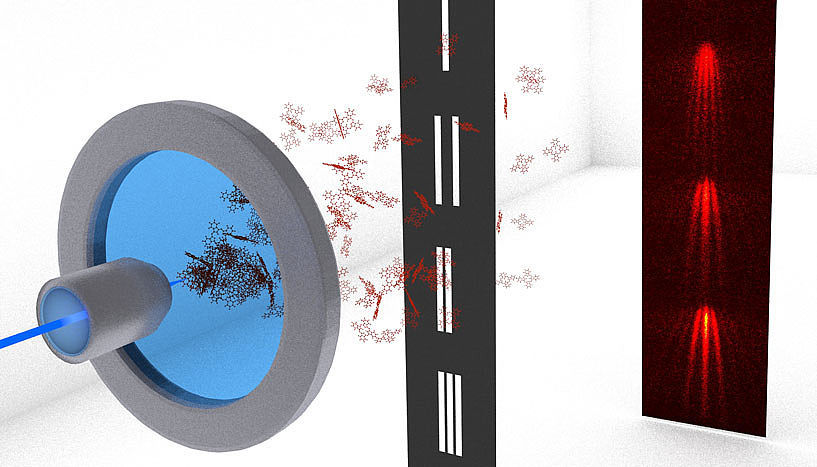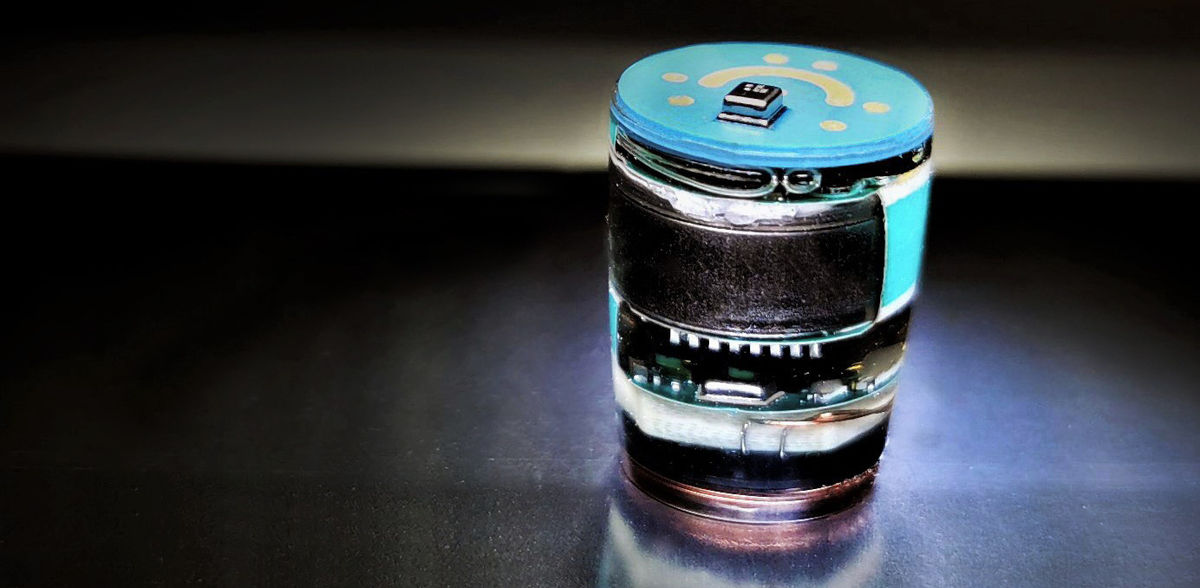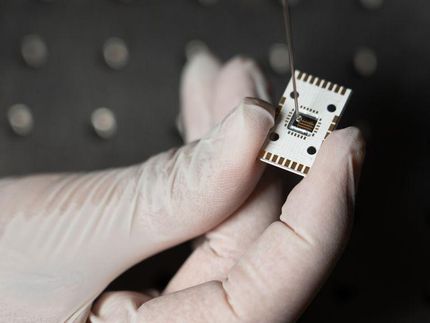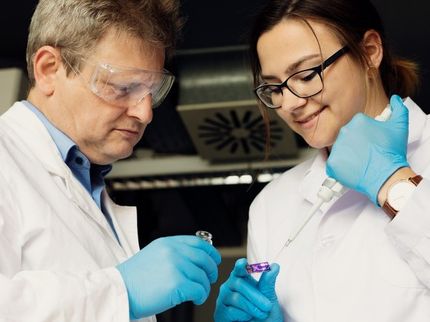The World’s Smallest Impedance Spectroscopy System in the Form of a Pill Finds Weak Spots in Machines and People
Small as a candy: Waterproof IoT sensor reliably measures the properties of liquids even in hard-to-reach places
Imagine a scenario where you simply just throw in a pill to identify an error—this is now one step closer to reality thanks to the work done by researchers at Fraunhofer IZM in cooperation with Micro Systems Technologies (MST) and Sensry GmbH. As small as a piece of candy, the waterproof IoT sensor can reliably measure the properties of liquids even in hard-to-reach places. This can make the maintenance of industrial machines much easier and even help to identify diseases.
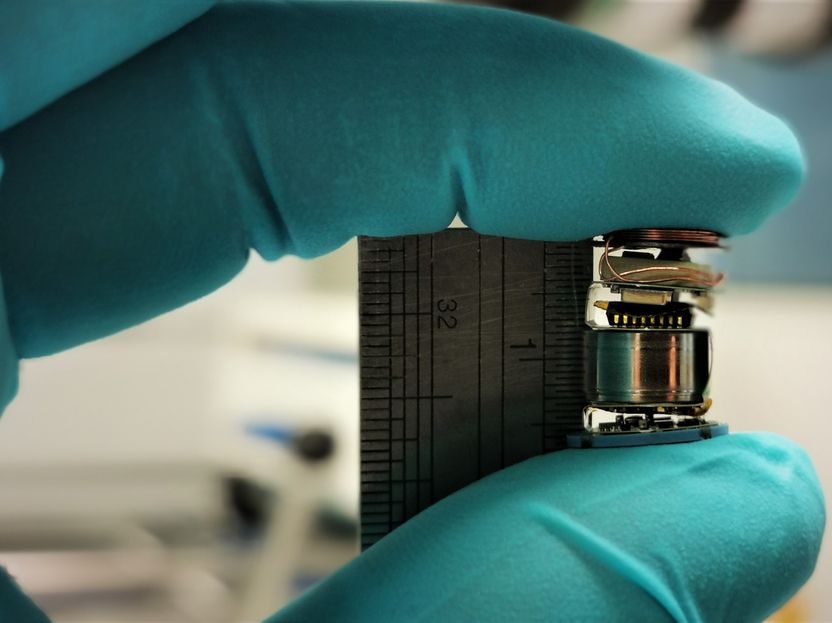
The core of the spectroscopy capsule contains the system-in-package, a flexible circuit board, and a ceramic pcb
© Fraunhofer IZM
The larger an industrial machine, the more difficult it is to troubleshoot malfunctions by detecting unwanted oil pressure deviations or even line leaks from the outside. It often takes a long time for specialist staff to find what seems to be the equivalent of a needle in a haystack. This can lead to production losses and high costs. The situation is similar with the identification of disease causes in humans. If a patient complains about abdominal pain, there is usually no way around a complex gastroscopy or colonoscopy. Electrochemical impedance spectroscopy can be very helpful in such cases.
In this process, radio waves are sent through a medium from one electrode to a second electrode in order to derive the frequency spectrum (i.e., the specific fingerprint) of the medium. If any changes in the properties of a material or a liquid are identified, this can indicate the fast-progressing corrosion of a component or the presence of a specific clinical picture. Previously, impedance analyzers were not small and portable enough to be used for this purpose. With these applications in mind, researchers at the Fraunhofer Institute for Reliability and Microintegration IZM in Berlin, with support from MST and Sensry, worked to develop a compact and modular IoT sensor that can measure impedances and transmit them wirelessly. As a result, the sensor is not only waterproof but also biomedically compatible.
The sensor consists of a biocompatible polymer, and despite its small surface area of just 11 × 16 square millimeters, it accommodates the two necessary electrodes, as well as numerous components for the analysis of environmental properties, including six sensors for measuring a wide variety of data parameters. In addition to environmental temperature, pressure, humidity, and sound, this small but extremely versatile device can also keep track of its own acceleration behavior, as well as rotation and ambient noise. Light and color properties can be detected via an integrated light sensor.
In a more concrete scenario, if a machine malfunction occurs, the sensor can be inserted into an oil line, for example, so that it flows through the entire system. Precise data on the properties of the environment is transmitted wirelessly in real time to a custom-made software with a web interface for PCs and smartphones. If the sensor reaches a point where the pressure or the liquid spectrum deviates from the requirements, this is an indication that the cause of the problem has been successfully localized. To make it easier for users to analyze the collected data, the frequency spectra of certain liquids, such as oil and water, are already included in the software.
The main challenge encountered during the manufacturing of the sensor was the miniaturization of the components. In particular, reducing the diameter of the coil for wireless charging to 10 millimeters proved to be a significant obstacle. However, a sophisticated system design made it possible to overcome this challenge. At the beginning of the project, Sensry GmbH provided their circuit diagrams and the firmware Kalisto as the basis for developing the sensor.
In order to ensure that a total of over 70 passive and active components could be fitted on a flexible and biocompatible printed circuit board, the circuit board was designed using a liquid crystal polymer and manufactured in four layers by DYCONEX, an MST company. Despite its multilayered design, the circuit board’s thickness is a mere 175 micrometers, which makes it about as thick as a human hair. A system-in-package was fabricated on a six-layer interposer and constitutes the core of the sensor, as this is where the IoT system is integrated. Thanks to a built-in induction coil, the device can be charged wirelessly using Qi technology without ever opening the capsule. However, classic DC charging is also possible via a docking station that is used for calibrating and programming the sensor. In order to prevent overheating of the components during operation, the sensor is filled with an epoxy resin that insulates the components from each other and dissipates heat to the outside. At the bottom, the sensor features a 0.5 millimeter thin four-layer ceramic board manufactured by Micro Systems Engineering GmbH, an MST company, which accommodates the electrodes for impedance spectroscopy as well as the pressure sensor. As a trade fair demonstration unit, the IoT sensor showcases how intelligent system design and semiconductor packaging can be used to greatly miniaturize electronics without sacrificing any functionality.
Research into electrochemical impedance spectroscopy is well underway, and the possibilities for medical technology are far from exhausted. The project has been running since April 1, 2021.
Topics
Organizations
Other news from the department science
These products might interest you

SprayMaster inspex by LaVision
Quality Control for Your Spraying Process Through Digital Spray and Particle Analysis
Reliable, Automated, Digital - The Geometry Measurement of Your Spraying Process in Real Time

FireSting-PRO by PyroScience
New fiber optic measuring device: Precise measurements even in the smallest volumes
Measure pH, oxygen and temperature even under sterile conditions

VEGAPULS | VEGABAR | VEGASWING by VEGA Grieshaber
Cyber-safe level measurement - here's how it works
Find out more about the unique sensor for liquid and solid media

Get the chemical industry in your inbox
By submitting this form you agree that LUMITOS AG will send you the newsletter(s) selected above by email. Your data will not be passed on to third parties. Your data will be stored and processed in accordance with our data protection regulations. LUMITOS may contact you by email for the purpose of advertising or market and opinion surveys. You can revoke your consent at any time without giving reasons to LUMITOS AG, Ernst-Augustin-Str. 2, 12489 Berlin, Germany or by e-mail at revoke@lumitos.com with effect for the future. In addition, each email contains a link to unsubscribe from the corresponding newsletter.
Most read news
More news from our other portals
See the theme worlds for related content
Topic World Spectroscopy
Investigation with spectroscopy gives us unique insights into the composition and structure of materials. From UV-Vis spectroscopy to infrared and Raman spectroscopy to fluorescence and atomic absorption spectroscopy, spectroscopy offers us a wide range of analytical techniques to precisely characterize substances. Immerse yourself in the fascinating world of spectroscopy!

Topic World Spectroscopy
Investigation with spectroscopy gives us unique insights into the composition and structure of materials. From UV-Vis spectroscopy to infrared and Raman spectroscopy to fluorescence and atomic absorption spectroscopy, spectroscopy offers us a wide range of analytical techniques to precisely characterize substances. Immerse yourself in the fascinating world of spectroscopy!
Topic world Sensor technology
Sensor technology has revolutionized the chemical industry by providing accurate, timely and reliable data across a wide range of processes. From monitoring critical parameters in production lines to early detection of potential malfunctions or hazards, sensors are the silent sentinels that ensure quality, efficiency and safety.

Topic world Sensor technology
Sensor technology has revolutionized the chemical industry by providing accurate, timely and reliable data across a wide range of processes. From monitoring critical parameters in production lines to early detection of potential malfunctions or hazards, sensors are the silent sentinels that ensure quality, efficiency and safety.
Last viewed contents
United_Kingdom_Climate_Change_Programme
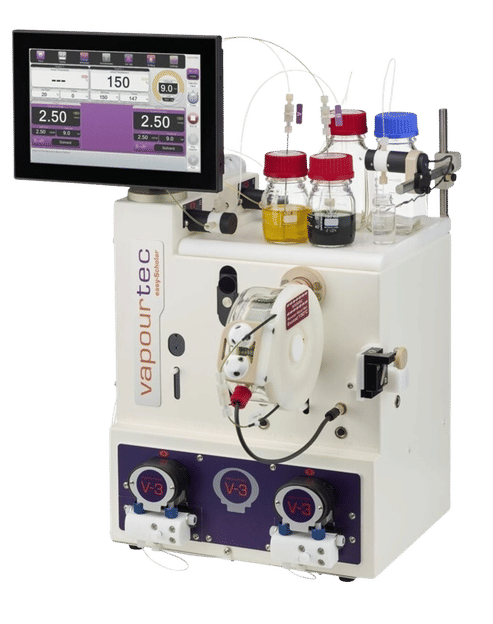
E-Series Flow Chemistry system | Flow chemistry systems | Vapourtec
Dirac_large_numbers_hypothesis

IceCube experiment finds Earth can block high-energy particles from nuclear reactions
Nucleophilic_addition

A Guide to the Different Types of Fat
Tourmaline
